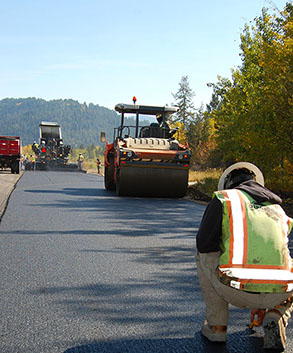The Idaho Transportation Department is overseeing more road construction than ever before. This work continues as temperatures are cooling and the ice and snow make their all-to-soon appearance. How does ITD successfully pave a road and have one of the shortest summer seasons in the country? Materials engineering and testing actually do make it possible.
Before asphalt pavement is ever laid, the surface where it needs to go is sprayed with a binder that will make it stick. This is called tack, a liquid made of oil and water. Tack must naturally break apart to become adhesive, separating as it lays across the surface where paving will happen. As it breaks, tack turns from a brown color to darker black, indicating that breaking has happened, and asphalt can be laid on top.
On the warmest of Idaho summer days, tack breaks in about ten minutes. When it’s colder, it can take hours. Still, with the right process, tack will break. ITD just knows it takes longer and plans accordingly.
Hot mixed asphalt is combined in a hot plant that can heat the components—crushed gravel and oil—to more than 300 degrees. This is dumped from a truck and spread using a paver, then compacted with a roller. ITD inspectors are on site anytime the contractor is, testing temperatures, compaction and much more to ensure that taxpayers get their money’s worth out of each project.
For quality compaction on state highways and interstates, the process must occur between 240-280 degrees. On warm summer days, asphalt must sit for a while after being spread before it is cool enough to be compacted. On colder days, asphalt loads hauled from hot plants are covered in transit to retain the most amount of heat. The asphalt will then be spread, and the roller follows closely behind to compact immediately before the material has cooled too much. All century-old, effective tricks of the trade in action.
“We don’t loosen up our requirements just because it gets cold,” ITD Materials Engineering Manager Mark Hayes said. “All contractors are held to the same quality materials standards and only operate when there are ways to do it right.”
Most of Idaho’s state highways run through rural areas, far removed from permanent hot plant locations. This fall, paving is occurring on State Highway 28 between Leadore and Salmon. The closest permanent hot plant sits in Idaho Falls, nearly four hours away. Enter the mobile hot plant erected by contractors at the ITD Leadore gravel pit, less than five miles from where the asphalt needs to be delivered.
In Rexburg, where paving is still occurring on multiple interchanges off U.S. Highway 20, the contractor’s permanent hot plant lies in Teton, less than ten miles away. Planning to have these proximities ensures that temperature requirements are met, and paving can be done successfully both earlier and later in the year.
Of course, there comes a cold enough ambient daily temperature that means paving operations are simply no longer viable. ITD requires that the temperature be 40 degrees and rising for paving to happen, which can result in fewer hours to pave during the fall but still allows a window of work. The right equipment, materials, planning, testing and operating tricks of the trade make it so ITD and contractors can pave with quality even when it is colder outside.
When you see paving equipment and a compacting roller working close together while your heater is on inside your car, know that ITD and the industry have the brief Idaho summers and cold Idaho temperatures on tap. That new road surface will meet the same metrics as summer paving, ensuring it lasts for many years to come.

